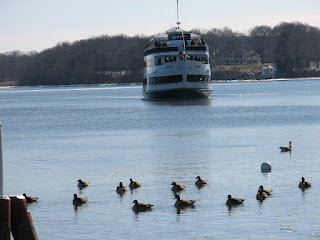
Saturday Morning I was at Joanne Luppi's
:Backyard birding in Portland. This is more than just a birding field trip-it's an annual tradition. This is the third year I've attended.
The weather was pleasant for a February morning. I'd guess it was in the upper 20's but it was sunny with very little wind. It had snowed overnight, leaving a coating on the roads.
This led to some people calling to say they couldn't make it. Debbie, who lives nearby, also joined us. She is a kindergarten teacher who tries to instill an appreciation of nature to her students by setting up bird feeders outside the classroom window. Debbie also enjoys riding horses and birding in her spare time.
Joanne, a retired English Teacher, first became interested in birds when she was a young girl. As a child, she grew up in a home with property that was bordered by The Pachaug State Forest. Her father was a Forest Ranger for Pachaug. Bluebird houses were set up on the property so she had the good fortune of being able to watch Eastern Bluebirds there. She has now come full circle, as her present house is bordered by Meshomasic State Forest
http://wikimapia.org/1558318/.
Later in life, Joanne and her family took trips to a pony farm in Chinoteague Virginia. It was here that she first noticed the beautiful white birds called Egrets. This furthered fueled her interest in birds. These days , Joanne finds birding a good excuse to take a trip and enjoy the outdoors. Her next quest is to go to see the Harlequin Ducks
http://en.wikipedia.org/wiki/Harlequin_Duck at Sachuest Point near Newport, Rhode Island.
We started out birding taking a walk along the road to visit some of the neighbor's bird feeders. The neighbors know in advance that there will be visitors during this trip and are happy to accommodate us. We got settled in to one location where we had nice views of
BLACK-CAPPED CHICKADEES at the feeders. These sociable birds always seem to be on a mission. We could see the
DOWNY WOODPECKERS and
WHITE-BREASTED NUTHATCHES working along the trees in the area.
EASTERN BLUEBIRDS and
CAROLINA WREN could be heard on opposite sides of the street.
After surveying some of the area feeders we returned to the house but we were not finished. Joanne has set up numerous feeders in her backyard, and the view through the picture window
is excellent. We were able to see many birds including
RED-BELLIED WOODPECKER http://www.birds.cornell.edu/BOW/REWO/ which was feeding on the suet. There were also three male
NORTHERN CARDINALS sitting in the rose bushes at one point. Cardinals seem to be at there most stunning when the area is blanketed with snow. I also enjoyed seeing a group of nine
BLUE JAYS feeding on the ground. Some people don't care for Blue-Jays because they come with a reputation. They are members of the family Corvidae (crow) , which are some of the most intelligent birds.
We took a break and enjoyed scones and coffee ( you're not going to get that on other field trips)
while observing more birds in the backyard.
Other species seen included: MOURNING DOVE, AMERICAN GOLDFINCH, HOUSE FINCH, WHITE-THROATED SPARROW, JUNCO, EUROPEAN STARLING, and HOUSE SPARROW. In the past week Joanne has also had a HERMIT THRUSH visiting her birdbath. In past years she has had YELLOW-BELLIED SAPSUCKER, RED-BREASTED NUTHATCH, and PURPLE FINCHES visit her yard. There has been fewer birds at her feeders this year, thus far. This is probably due to the unusually warm start to this winter. The birds have not had a need to use feeders as a food source with all of the natural food that has been available.
This yearly event is an excellent way to introduce someone to the joys of birdwatching. If you have a child who seems to have some interest in birds ,this is the place to go. It's also a comfortable way of seeing a nice variety of birds in the midst of winter.














